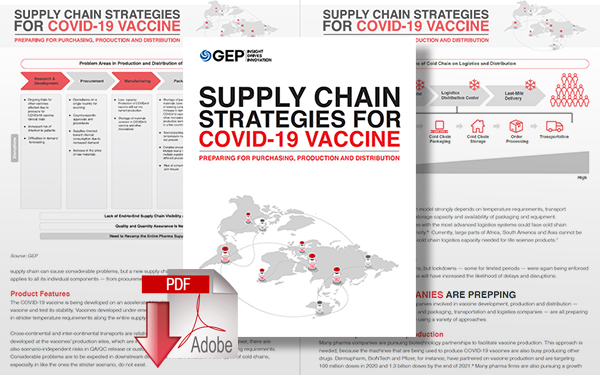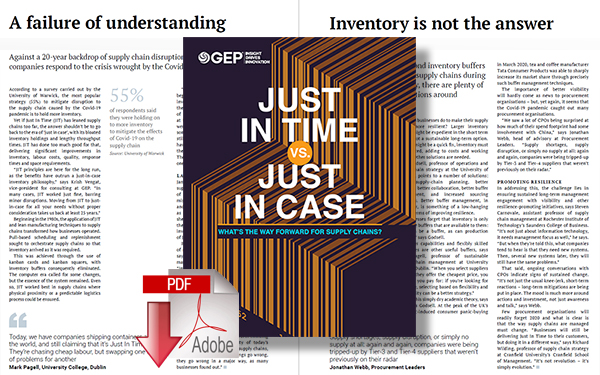3 Crucial Supply Chain Lessons from COVID-19 Vaccine Rollout

The complexities in getting a new vaccine supply chain running efficiently underscore some larger lessons for how supply chains operate in the new normal of the post-pandemic world.
Lesson Learn't Producing and Distributing COVID-19 Vaccines
- Effective collaboration is essential – for all supply chains
- Supply chains must be flexible to meet unique challenges
- Digitalization of the supply chain supports those requirements
Since the first COVID-19 vaccines were approved in December last year, vaccine manufacturers have had to develop novel supply chain strategies to handle speedy production as well as safe distribution of tens of millions of life-saving doses.
With limited information on the stability of the pharmaceutical components on hand due to the accelerated vaccine development process, cold-chain equipment and facilities became crucial links in the complex supplier network.
In light of that need, vaccine makers began sourcing dry ice along with the equipment to produce it.
And the other nodes in the supply chain, such as vaccine distributors and pharmacies, have looked into sourcing ultra-cold freezers from ice cream manufacturers to keep the vaccines at the required low temperatures.
These are just some of the challenges the developed world is facing with regards to producing and distributing the COVID-19 vaccines.
Developing countries with limited access to cold-chain technology are likely to have it even tougher.
The complexities in getting a new vaccine supply chain running efficiently underscore some larger lessons for how supply chains operate in the new normal of the post-pandemic world.
3 Lessons Supply Chains Can Learn From the COVID Vaccine Rollout
1. Complexity isn’t going away. As vaccine manufacturers and distributors have discovered, supply chains are increasingly complex systems that generate their own unique challenges. Components need to be stored, shipped and delivered at low temperatures for millions of vaccine doses that need to be administered – and then administered again to achieve the right efficacy. These complexities of supply chains are not going to disappear, no matter what strategies enterprises adopt to manage the risks that complexity brings with it.
2. Supply chain collaboration is more important than ever. Across all tiers of the supply chain, effective and efficient collaboration is essential. To cope with new problems and break down the silos that tend to develop across enterprises, the role of a supply chain management software platform becomes crucial given its ability to orchestrate the elements harmoniously.
3. Flexibility is a critical supply chain capability. This is driven by a mindset of innovation and creativity, as seen in how companies looked to new avenues for the necessary cold-chain equipment. Flexibility is also enabled by supply chain software, which is helping enterprises identify potential bottlenecks and execute solutions. And that will make them more resilient to future disruptions.
The Growing Need to Digitalize Supply Chains
As the unique strategies developed to resolve the COVID-19 vaccine production and delivery challenges show, the transformation of supply chain management has become imperative in today’s volatile business environment.
By digitalizing supply chains, getting a handle on diverse data streams, and harnessing analytics to better predict potential issues and outcomes, companies can strengthen their supply chains and take advantage of the lessons learned from the pandemic.
Sourcing in 2021: The Business Case for Just-In-Case Supply Chain
- Pandemic has made supply chain risk management a top priority
- Just-in-time strategy has been ineffective in adverse market conditions
- Can just-in-case sourcing model shield against risks and be cost-effective too?
The past year compelled businesses to rethink their sourcing strategies as the COVID-19 crisis exposed the cracks in global supply chains. Amid supply chain disruptions, businesses have had to reassess inventory needs and management. Now, with a view to future-proof their operations, they seek ways to build an agile and resilient supply network.
As many supply chain leaders now get their voices heard in boardrooms, the consensus is to implement much-needed reforms in supply chain management. One of these is shorter supply chains that offer more resilience. Another one involves reassessing the effectiveness of the popular just-in-time or JIT model.
Should enterprises look beyond just-in-time?
Designed to reduce costs and eliminate the need to store excess inventory, the JIT strategy relies heavily on a strong and efficient supplier network. The objective is to increase efficiency and reduce wastage by moving materials and components only when needed.
However, this strategy can be effective when each operation is synchronized with the subsequent operations. In case there is a sudden disruption, this process fails and impacts business operations, as seen during the widespread lockdowns in early months of the pandemic crisis.
Dealing with a disruption of the magnitude of COVID-19 has exposed the drawbacks of JIT, along with a lack of visibility into the supply chain. Too much focus on reducing costs meant this model failed to provide a steady supply of key products.
Enterprises that relied heavily on JIT realized they could not meet a sudden spike in demand. Plus, the absence of a Plan B for core suppliers aggravated the possibility of businesses running out of stock.
The growing consensus for just-in-case
In the past, business leaders overlooked the need to review and introduce vital changes in the way they managed supply chains. After COVID-19, their focus has shifted from cost to risk management.
An increasing number of enterprises are looking to adopt a just-in-case supply chain model. This means that businesses maintain a safety stock to meet a sudden or unusual spike in demand. Safety stock also provides a shield against production or quality issues and unforeseen events.
In addition, enterprises realize the need to diversify their supplier base and reduce dependence on a few main suppliers or a single region. Diversifying can ensure a steady supply of key products, even in critical times. Many enterprises also plan to expand their warehousing footprint across different regions to ensure uninterrupted supply.
Can a hybrid model emerge?
Supply chain leaders are concerned about the costs involved in maintaining and storing surplus inventory for a just-in-case scenario. Some enterprises may choose a hybrid model that can meet the inventory requirement as well as maintain the efficiency of JIT.
Others may prioritize risk management and adopt a just-in-case strategy irrespective of the extra costs involved.
One thing is certain in the post-COVID-19 times. Supply chain management will continue to evolve and assume paramount significance. Enterprises are likely to consider the pros and cons of different sourcing strategies as well as their changed business priorities to choose a strategy that best suits them. It is also the right time to invest in technology and choose a supply chain management software that can provide the much-needed, end-to-end visibility and resilience.
Related Resources
Supply Chain Strategies for COVID-19 Vaccine: Preparing for Purchasing, Production and Distribution
In this GEP paper, Supply Chain Strategies for COVID-19 Vaccine: Preparing for Purchasing, Production and Distribution, we explore how pharmaceutical companies and their partners are gearing up for a global inoculation push that’s unprecedented in modern history. Download Now!
Just in Time vs. Just in Case - What’s the Way Forward for Supply Chains?
This latest Procurement Leaders paper - Just in Time vs. Just in Case: What’s the Way Forward for Supply Chains? - shows why supply chain managers should shift their mindset with regard to inventory. Download Now!
More Resources from GEP
Article Topics
GEP News & Resources
GEP Procurement & Supply Chain Tech Trends Report 2024 How Procurment and Supply Chain Leaders Should Handle Supply Chain Disruptions Optimizing Business Outcomes by Investing in Sustainable Supply Chains and Procurement Optimizing Direct Material Sourcing with a Unified, Extensible Source-to-Pay Platform Generative AI in Procurement Navigating the Cost-Plus World of Supply Chains How to Avoid the Pittfalls of Contract Management in Telecom and High-Tech More GEPLatest in Supply Chain
Microsoft Unveils New AI Innovations For Warehouses Let’s Spend Five Minutes Talking About ... Malaysia Baltimore Bridge Collapse: Impact on Freight Navigating TIm Cook Says Apple Plans to Increase Investments in Vietnam Amazon Logistics’ Growth Shakes Up Shipping Industry in 2023 Spotlight Startup: Cart.com is Reimagining Logistics Walmart and Swisslog Expand Partnership with New Texas Facility More Supply Chain
















